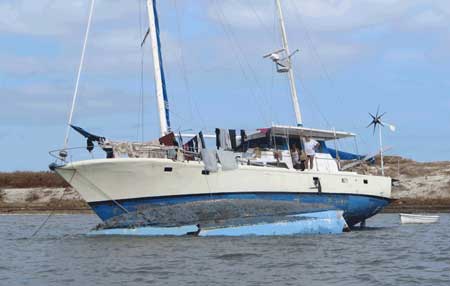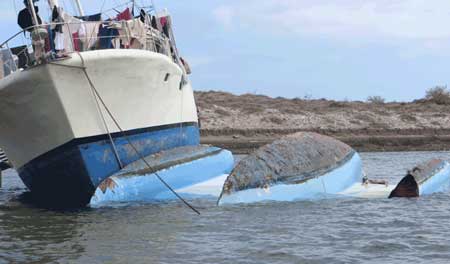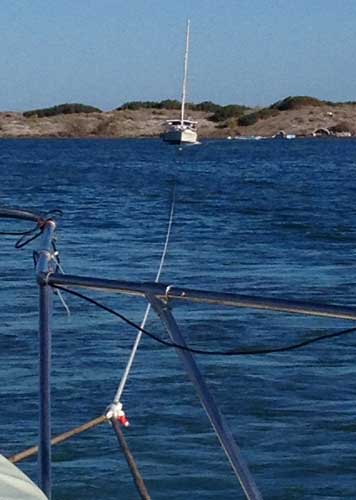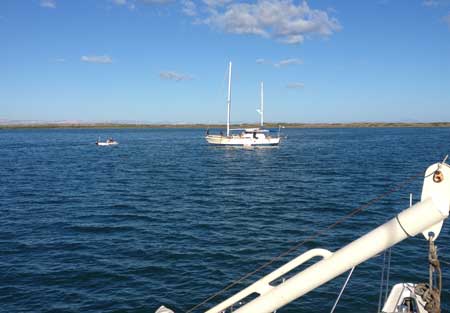Cheating Hurricane Odile
Article contributed by
Charles Moorhead
s/v
Shadowfax
The Situation
On September 14th, Hurricane Odile did real damage to the Mexican Baja Peninsula. Even now two months later, roofs are gone, streetlights and stoplights are inoperative, and signs are gone. Several people, including three from the La Paz cruising community, lost their lives in the storm. Several boats were lost. Up until Sunday morning, November 23rd, many of us feared that included Seamentress, a 55 foot 40 ton ferrocement ketch.

Seamentress, with her owners Paul and Fili aboard, had been dragged at least six miles from her La Paz anchorage location deep into Bahia de La Paz and up onto the beach at just about the most remote location possible. At low tides, the nearest water could be several hundred yards away. At the highest tides, she was in four to five feet of water, and needed a good six feet to float. She was hundreds of yards away across a sand and mud bottom from water that would float her.
Paul had made an unlucky, but not necessarily bad decision, to weather the hurricane in the anchorage as opposed to tying up in one of the marinas offering free moorage to boats in need of shelter. In past hurricanes, boats in these marinas had been badly damaged or lost. This time, the boats in the marinas were fine while it was the boats in the anchorage who suffered. With hurricanes, who knows? Seamentress might well have been OK in this storm but for a derelict trimaran that broke loose from whatever was holding it, flipped over and hit Seamentress during the worst of the storm. Paul heard a tremendous bang and knew he had started dragging, but between the wind and the dark, he couldn’t see what was making the racket. He deployed his second anchor to no avail. He didn’t really discover the derelict until the next morning, under his beached home, which was laying on her side at about a 45 degree angle.

There is a wonderful cruising community in La Paz that has been here for many years. Paul and Fili are well regarded members of this community. Fili, who is a Mexican physician, has been known to provide medical care to cruisers whose wallets were a little too slender to obtain care by other means. Most of the salvageable boats beached by the storm had already been recovered. These recoveries took hours of backbreaking and somewhat dangerous work by members of the community. But not Seamentress. After two weeks, the boat was sitting upright held by anchors to the masthead and poles stuck in the sand. The derelict had been largely cut out from under her. As fate would have it she lay on the beach in an area where permission to dredge a channel would not be possible. Shovels and a water jet dredge were all that would be allowed. Much digging of channels in the sand had been done, and several high-tide pulls had been attempted with powerful twin-screw boats, all to no avail. The boat had moved, but only several grudging feet at a time. Two months after the storm, it was looking grim. There was only one more tide greater than four feet available in the bay until July!
The Scheme
None of us wanted to just let this go. I was at a Rotary function serving drinks when Rob, from Cross Marine Works stopped me and said he had some experience with salvage and had an idea involving adding flotation with plywood boxes. A few days later we planned to meet on our boat Shadowfax to design a way to “lighten” Seamentress sufficiently to drag her into deep water. In the meantime, I got to wondering how the docks in Marina de La Paz floated and asked Neil Shroyer, whose family own and operate the marina, where he got his flotation. He gave me the address of a block plant just outside of town and showed me what $9000 pesos worth of Styrofoam looked like for comparison. We made a run to the Styrofoam plant and learned they had blocks of the stuff four feet, by two and one half feet, by ten feet they would sell us for $2000 pesos. A little computer work later, we determined that one of these would provide a little more than three tons of flotation.
The meeting was a good one. My long time sailing friend from Vashon Island, John Burke, was with us for a visit. John has his hundred ton Master’s license and is good at building things. Rob and Kim from Cross Marine were there, as was Al from Tuna Tamer and Dave from Ansa, both of whom had been involved in boat rescue from the time the storm died down. Everybody seemed to understand that their pet ideas were being picked on not out of spite, but out of a desire to thwart Murphy’s Law and get Seamentress floating again. We only had one more tide cycle to work with; then tides would not be high enough until this coming summer! After an hour or so of good discussion, Paul arrived. I somewhat jauntily told him we had him floating and were working on the details of the celebration party. That would prove to be just a tad optimistic.
The solution we arrived at is as follows: Two pairs of large Styrofoam blocks would be positioned as low down on the hull as was practical, one pair forward and one pair aft. If we could arrange the blocks so they were totally submerged at high tide, we would gain 12 tons of lift against the boat’s 40 ton displacement. Each Styrofoam block would be fitted with three corner boards. To make the corner boards, you obtain two 10 foot wood 2x4s (for a 10 foot long block), lay them parallel on the ground a few inches apart, and nail or screw hinge straps between the 2x4s. The corner boards protect the Styrofoam blocks from the ropes holding them under the hull so the ropes don’t simply cut through the Styrofoam under load. Each pair of blocks would be held under water by three loops of line spread out along the length of the block. These would lift the boat. The loop design starts by going around a block, then under the hull, then around the second block, then under the hull again and finally tied to itself. We could “drill” under the hull through the loose sand with the water pump jet, threading the line tied to a length of rebar. The blocks were further secured to the hull with additional loops of line around the entire boat and block pair, tensioned with a chain hoist or come-a-long on the deck. It also proved necessary to lash the lifting loops together along the length of the hull to prevent them working loose and freeing the blocks.
At low tide it was necessary to excavate holes in the muddy sand to fit the blocks in position against the hull under the boat. It is truly hard to describe in words just how much effort these activities took, all necessarily time-constrained by the returning tide. By Friday morning November 21st, we had a 4.0 tide and our first test. We tried moving the boat with a couple of pangas with 60 and 90 HP outboards on them, reasoning that the boat would now freely float and we could just drive away with it. It did float a few feet, but then stuck again. We needed more floatation, and we needed it quickly. Sunday was the best tide, and after that it was July. We quickly bought one more Styrofoam block, sawed it in two and fitted it between the original two pairs. We now had 15 tons of lift or more from the five large Styrofoam blocks. We also tied in fenders, water bottles and anything else we could find to contribute to the lift.
Sunday we had scheduled a big twin-screw powerboat with lots of power to pull, but he couldn’t get up on the beach to reach Seamentress without grounding himself. We scrounged and bought enough one inch line to reach nearly 1000 feet to safe water. We taught ourselves the Carrick bend to join these lines together. This is a knot not often seen in yachting circles, but is considered the best bend for workboat lines under towing strains. We rigged a towing bridle to get the towing force down low on the boat. Several folks also dug and marked a shallow channel toward deep water literally with shovels and sweat, gaining precious inches of water the boat could be hauled through. We would leave nothing we could think of undone to give ourselves this best last chance.

I think the work parties organized for this effort included nearly thirty people. Some worked a lot, some worked a little. All of them gave what they could to the effort. It was a 30 minute panga ride to the work site and another 30 minute ride back, all of course depending on the weather. You got to wade to the boat from the panga for several hundred yards. These waters have sting rays in them, so you were constantly focused on disturbing the rays to get them to move before you stepped on one and got stung. Then you got to work in the muddy sand in the shadow of a 40 ton boat standing upright on its keel, and supported by some slender poles while your mates blasted away at the sand under the keel with the water jets. You would ask the fellow next to you “What do you think”? The usual answer: “I don’t know...”
The Big Day
I don’t think many of us slept much Saturday night, even as tired as we were. The only comfort was we had done everything we could think of. We just didn’t know if it would be enough. Sunday dawned and we got up bright and early to see what we would see. Oso Negro, the big twin-screw powerboat, left to be on station early. We ran the towing hawser out to him and settled in to wait for the tide. About ten minutes before the predicted maximum tide, both Seamentress and Oso Negro powered up and started to churn the water. The boat moved! But then, after only perhaps another boat length, it lurched to a stop. Our hearts sank. But Paul radioed that he had absolutely no steerage while under tow, and the tow boat had pulled him into the spoil from the channel we had dug. He needed the tow boat to reposition and we would try again. He did, the powering up process repeated and Seamentress took off trailing mud and disturbed sand clear out into eighteen feet of water. I don’t think I have ever seen a prettier sight!
Afterward

Paul still has a lot of heavy work ahead of him. He moved much of his stuff off the boat and onto the beach to lighten the boat. The logistics have not improved, as they are still a long ways from anywhere and now have to dinghy further than before to get to the boat from the beach. Getting those foam blocks out from under the boat was downright exciting, I hear. One of them launched itself nearly 20 feet from the boat after the loops holding it were cut. Seamentress did quite the jig as these blocks were cut away. The work crew did use a sharp knife on a long pole to cut the loops, so were not too exposed to these forces.
Members of the various work crews see each other on the street, or at coffee at Club Cruceros, and grin at each other and clap each other on the back. Nothing needs to be said. We know we worked very, very hard to accomplish something very difficult and very much worth doing. We’re proud of it. And we know how close it was, and how lucky we were. Cheating a hurricane of its prey is hard, but very gratifying!
Not this time, Odile!